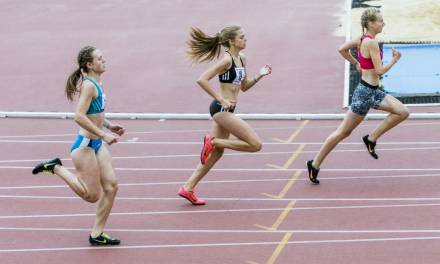If you try to simply sprint for the finish line when you’re running the 100m, you’ll never reach your full potential. To get the best time takes more than running flat out; a combination of speed, endurance and impeccable technique produces the best results.
Therefore, when you’re coaching athletes to run this shortest sprint, it can be beneficial to add in some other distances such as the 400m. The two races demand very different approaches and different athletic attributes to succeed, but there are some common factors which mean they complement each other.
Practice Your Posture
The 100m is such a short race it’s possible to muddle through to the end without ever having good posture or technique. You won’t achieve the best time unless you get these factors right but you may not even realise that you have a problem.
The 400m is much more demanding technically; due to the distance it can’t simply be sprinted from beginning to end. Running an entire lap of the track gives runners the time to focus on their posture and to develop a strong style. An engaged core, relaxed shoulders and a downwards stride (rather than forwards) will help to maintain power and speed without risking injury.
Holding the correct posture and positioning while you’re sprinting hard is extremely challenging and requires explosive strength (as opposed to explosive power). Running the 400m regularly will allow runners to develop the kind of strength needed to maintain this posture for the full 100m.
In the shorter sprint, you won’t want to remain upright for the entire race as the first portion is spent much lower, driving forward. However, runners will gradually move into this position after the first 25-30 metres and having the right technique will help to retain as much speed as possible to the end.
Endurance
The 400m is a long sprint and to get a good time requires the ability to balance technique and raw talent, harnessing the explosive power and bringing it out at the right moment. Any runner who tries to sprint at full speed from the start will find they very quickly start to fade, producing a far slower time than if they’d set out more steadily.
The need to produce a top speed sprint finish when you’ve already run 300m means that the 400m is one of the most physically demanding distances. But these skills will help sprinting at shorter distances too and could just provide the competitive edge.
Many 100m sprinters relax when they approach the line, thinking they have the race won only to be overtaken by another runner who seems to have a late burst of speed. In most cases, it’s not that another runner has sped up, it’s that they’ve perfected the art of slowing down their deceleration. In the last 30 metres of the 100m, all runners will be gradually decelerating and the key is to reduce this as much as possible.
Having the endurance to keep sprinting beyond the line could make the difference. Regularly running 400m improves overall conditioning and fitness, providing 100m sprinters with the stamina to keep their speed by reducing deceleration as much as possible.










